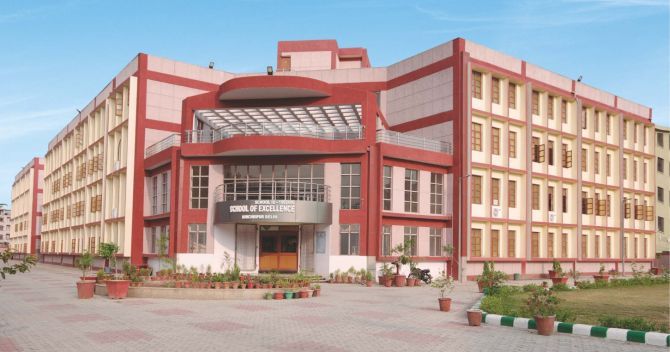 | « Back to article | Print this article |
Their effort is beginning to show results. Students from private schools are now joining government schools, says Anjuli Bhargava.

On a cold January morning, the School Of Excellence in Delhi's Kalkaji is abuzz with activity.
A long line of boys on either side of the drive-in await the arrival of Delhi's Deputy Chief Minister Manish Sisodia to hand out tablets to students who have achieved more than a certain percentage of marks in their board examinations.
An attractive incentive to my mind for a tech-obsessed generation!
I accompany the deputy minister and his small team of two in his vehicle, no laal batti (red light), howling sirens or security in tow.
The normalcy of it all surprises me, so accustomed am I to ministers who acquire a halo and radiate power almost as soon as they take charge.
We chat all the way on the reforms his party has undertaken in Delhi government schools, the first and the only state government to make school education a political issue.
The Union Territory has 1,029 Delhi government schools with roughly 1.6 million students enrolled.
There are an additional 2.8 million-odd students studying in the usual mishmash that we have made of our education system: 1-1.2 million in primary schools run by the three municipal corporations, all of them currently under the Bharatiya Janata Party besides those in private aided, private unaided schools, unrecognised and so on.
It's a holy mess.
I skip the function and the speeches once we reach to take a tour of the school and chat with the students I find.
I meet a group of boys, several of whom have joined the school a year back, mostly from private schools in the area.
I question them for a while on when and how they ended up joining this school and how they like it.
The school building itself is like a mid-range private school, closer to a DAV school or Ryan International than an Amity or a DPS, but a far cry from a typical government school anywhere in India.
The notice board on the day I am there is full of colourful charts and drawings, conveying energy but that may well be in view of the event in progress.
I have been hearing about the Delhi education reforms undertaken for over three years now in dribs and drabs, but this is my first and very cursory exposure to what is being attempted. It is ambitious and, if it succeeds, it can be far-reaching.
The Aam Aadmi Party has embarked on the noble mission of making quality education more inclusive by offering at no cost an option as good as a private school might.
In the process, it hopes to lure students back from the plethora of private options that have sprung up as an answer to the broken state system.
To its credit, it is not outsourcing the job to someone as politicians and bureaucrats facing a broken situation tend to do. Here's my problem, now you fix it.
Sisodia and his team have jumped in with missionary zeal and been at it for the last five years.

In many countries with robust state-run and financed systems, a majority of students attend a school usually in the neighbourhood that offers a high quality of education, as good as any available private options.
But Delhi's efforts are closer to Tony Blair's London Challenge, where the government-run schools in London when Blair took charge were at the bottom of the barrel in national assessments. After a multipronged reform exercise, the city's schools climbed to the top, with many parents choosing them over exclusive private ones.
Expecting an overnight change in Delhi schools would be naive.
Fixing the rot that has set in over the last three decades will take much more than five years.
Some of the early and easier to tackle results are visible.
Infrastructure in schools has improved, teachers are being given their due importance, accountability is being introduced but a visible and sustained change in culture is still a far cry.
To make a real dent, it is important that the 1-1.2 million students in the city who study in the municipal primary schools as of now be brought under the Delhi government fold -- whichever the city's government may be.
As things stand, most municipal school students arrive to study in Delhi government secondary schools at the age of 11-12, far behind their years.
Unless the change is wider and all encompassing, it may not be impactful.
A public interest litigation that demands this is pending.
Last but not least, the ability of the Delhi government to handle the backlash as and when it happens will be critical.
Unhappy murmurs are already being heard from the budget private schools but the moment, the pinch begins to hurt, the education mafia and lobbies will kick in.
That's when the real acid test for the Delhi school reforms will begin.
This story is far from over.